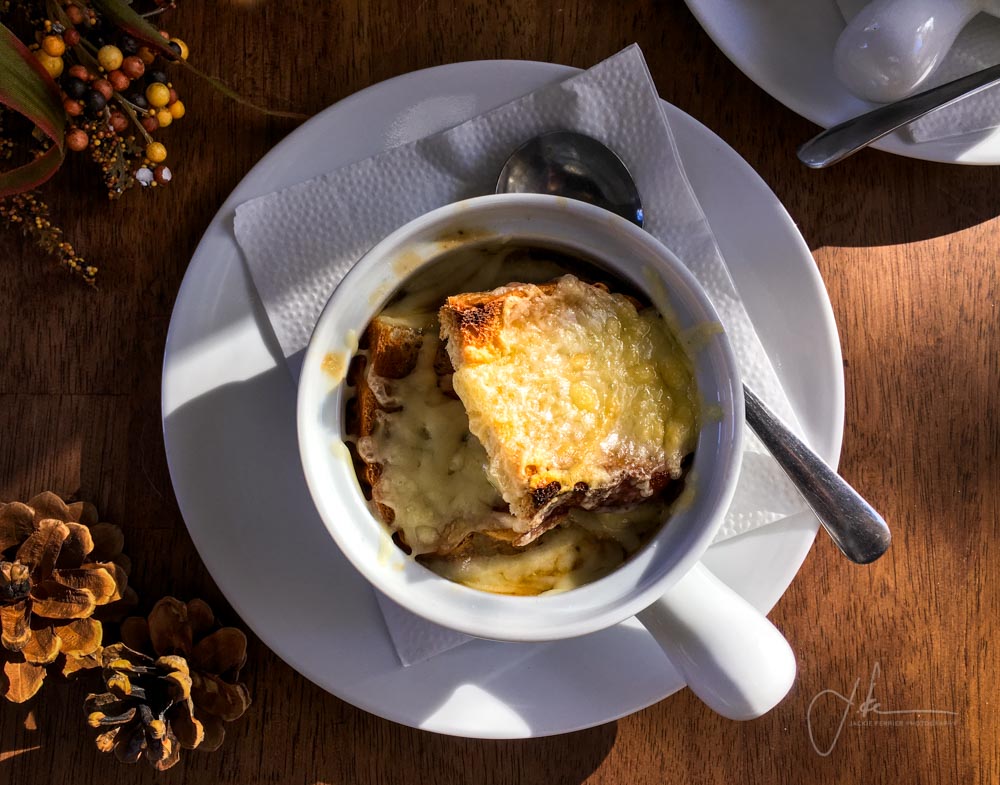French onion soup has got to be the ultimate cold-weather comfort food.

You can find onion soup recipes that call for chicken or beef stock, wine, flour, onions, dijon mustard, sugar (why?), different herbs, salt and pepper and so on.
But here is the secret in the flavour: it’s all about how you cook the onions.
With that in mind, French onion soup just got way easier: start with the basics and then decide what and how much you want to add to it. Why is this called a Canadian Onion soup? Because it uses beer (of course!), cheddar (the most popular cheese for Canadians), and because it’s just so darn easy-going.
Ingredients
(serves four – can half or double the recipe as needed)
- 1 kilogram onions (or about 2.2 lbs, or about 12 small onions)
- 50 grams unsalted butter (or about 3 1/2 tablespoons)
- 2 teaspoons flour
- 12 slices baguette (toasted). You can use other bread, too.
- 225 grams (1 cup). Or more! who are we kidding??) grated cheddar or gruyere cheese, but cheddar is more… Canadian, eh?
- 1.5-2l of water, stock, or water with some bouillon (or 6 – 8 cups)
- 473 ml can of beer (brown ale is a good one to start with)
The Bowls
French onion soup bowls are thick ovenproof bowls with lids and little handle(s) on the sides. You can often easily find these up at second-hand stores! The advantage of these bowls is that you can put them in the oven and they can withstand the heat of broiling, and while you wait for the handle to cool down, the lid keeps the soup warm.
If you don’t have french onion soup bowls any oven-proof soup like bowl will do.
Failing that, grill the bread and cheese separately and then put them on top of the soup after. It is more aesthetic and interesting to eat when all broiled together but sometimes you have to make do with what you have!
Directions
Melt butter and cook onions for an hour or more (Med-low heat)
Slice the onions into quarter-inch (6mm) rings. You don’t need to be fussy about this.
In a pot (ideally a non-stick pot with a glass lid, such as a braiser pan), throw in the butter and cook the onions on medium-low or low heat (depending on your stove and element). On my electric stove, I started at about a four and a half out of ten on the dial and then lower it to a three and a half once all of the onions are heated thoroughly. The length of time this takes depends on the size of your pan, how full of onions it is, etc.
The heat should be low enough that burning the butter is not a concern. If you are not sure what this setting is on your stove, go lower than you think. You can always raise the heat a little later. But if you are just a fool in the kitchen concerned you can put a little olive oil in to keep the butter from burning or add a little water from time to time.
Once the onions are all heated, you are going to cook the onions for at least an hour if not longer. I cook mine all afternoon usually. Slow, sow, slow. The longer they cook the sweeter they become, and you don’t want to burn them. This allows me to get other things done.
You can cook this without a lid, but the onions cook less evenly and you will need to stir them more often, and add water much sooner.
You will know the onions are ready when they are dark brown (but not burnt!). If you are used to cooking onions on medium heat for chili or a spaghetti sauce, you may not even know what this looks like! Let them cook until they’re actually brown. Not golden-leaves-you-wondering-if-this-is-the-brown-they-meant colour, and definitely not black. Aim for a no-doubt-brown colour.
Add flour once onions are brown
Add the flour and stir for a minute or two. Contrary to what some recipes state, the flour is not added so the onions don’t burn, it is added to provide a little body to the soup itself. But you do want it to cook a little and add it before the water to prevent lumps.
Adding beer and reduce
Other recipes talk about reducing half of the beer by half and then adding it to the soup and adding the other half and cooking for half an hour.
Some recipes call for reducing half a can down to almost nothing. In a lager or brown ale, this creates a really tasty sweetness.
This is where you get to experiment, but here is a starting point:
Pick any beer you love, but if you are not sure, start with something brown and malty as it will add to the flavour nicely. On the other hand, a lager will do fine.
If you like your saisons and sours, pick something that is similar to a wine.
If you love your bitter beer, you might try an IPA with a lower ibu score (is there such a thing?) but that bitterness is really going to stand out and not everyone will enjoy that in onion soup that is typically meant to be rich and on the sweet side.
If using a more bitter beer definitely use a sharp strong cheddar to balance it out.
Add water or stock and cook for 10 to 15 mins
Then you add the other half with the water and cook it for ten to fifteen minutes if the beer is reduced substantially, or a half-hour if you decided to add had of the beer later as desired.
Adding toasted baguette slices and cheese
Toast slices of baguette (enough to cover the tops of each bowl). This dries out the bread and adds a little firmness to it which is what you want for soaking in soup. This is the perfect way to use up a left-over baguette.
Ladle the soup into french onion soup bowls to about 2.3rd or 3/4s full.
Keep in mind that you will be added slices of bread and cheese to them, and you will want to cover the bowls with their lids after the cheese has been melted to keep the soup warm while the sides of the bowls cool down.
Add one or two of the toasted slices of baguette to the top and added the grated cheese on top of that. Did you add enough cheese? Should you add so much cheese to that? You probably should. Just make sure that by the time it has melted you can get the lids on.
Broil
Put the bowls on a baking tray or pan and put on the top rack in the oven and broil until the cheese bubbles. If you really want it perfect and your cheese cooperates, keep it under the broiler until just a little bit of the cheese just starts to brown. But watch that you don’t burn any tips of the baguette. If that happens take it out right away.
When the cheese has nicely bubbled and browned just slightly, pull the bowls out of the oven, and cover the bowls with the lids. This allows the soup handle to cool down without the soup itself cooling too much.
TIPS
TIP: Onions do shrink a lot so don’t worry too much if your pan is crowded. On the other hand, if the pan is really crowded (let’s say you’ve doubled the recipe) it will take more of your time as you will need to stir it from time to time, but if the heat is low enough, you can actually go do other things (just keep in mind that most house fires start in the kitchen, so… be sensible).
TIP: Don’t add all the water when it comes time to add water initially. Just add what you need to keep it soupy, and add more as it reduces.
Try adding one more of the other ingredients as you like (but none of them is necessary):
- Garlic (add just one minute before the liquid is added)
- Thyme
- Bay leaves
- Beef stock or bouillon in place of or added to the water.
- Dijon mustard
- Salt & pepper
Enjoy!
